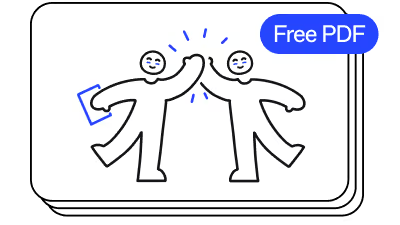The ultimate one-on-one meetings guide for managers & employees

%20(1).png)
Everything you need to know about making one-on-one meetings more efficient and productive.
Having regular one-on-one meetings with employees is a key way managers can keep their team members aligned on common goals, and support each person’s professional development. These conversations are a moment to connect on a human level and build foundations of trust and understanding.
Employees who are satisfied with how frequently they communicate with their manager also…
- Feel that their manager cares about their opinion.
- Are satisfied with their level of autonomy at work.
- Report really feeling that they are a part of a team.According to data from Officevibe’s employee surveys
Here, we cover everything you need to know about making these important conversations as impactful and productive as you can.
First, what are one-on-one meetings?
Before we get deeper into the topic, what is a one-on-one meeting? By definition, a one-on-one is a meeting between two individuals working for the same company.
Usually, one-on-one conversations happen between an employee and their manager. These discussions are a great way for managers to check in with each team member and create meaningful connections.
On the employee’s side, these meetings are a chance to discuss their career path with their manager and raise any challenges they’re facing. They’re a moment to address any uncertainties and ask for support wherever they need it.
Often, a manager will book a recurring calendar event with each direct report, to make sure they’re checking in regularly. These meetings should always start with talking points or a structured agenda, and end with clear action items for each person to focus on until the next meeting.
What is the purpose of a one-on-one meeting?
There are several reasons why managers and direct reports should meet regularly. The purpose of one-on-one meetings might be different depending on the employee’s goals, the team’s context, or the manager’s management style.
Some one-on-one meeting purposes include…
- Building and maintaining manager-employee relationships
- Making space for individual or personal conversations
- Setting employee goals and tracking their progress
- Exchanging feedback and coaching performance
- Spotting and addressing employee challenges
Ultimately, it’s up to the manager and employee to define what the purpose of their meetings will be. Setting one-on-one meeting goals helps two people align on what they want to accomplish from their dedicated time together. These can be short-term goals that they set and tackle from one week to the next. Or, they can be long-term goals that they chip away at over time.
Why are one-on-ones so important?
One-on-one meetings are an essential part of the healthy functioning of any team. Maintaining ongoing communication between managers and their direct reports helps build trusting, authentic relationships. And this is very important because the relationships people have with their bosses can make or break their job satisfaction.
Only 60% of employees are completely satisfied with the communication they have with their manager.Officevibe’s employee Pulse Survey data
For managers, one-on-one meetings give them a high-level view of what everyone on their team is working on. They also help them spot any employee challenges, performance issues, or interpersonal conflicts that need to be addressed. And of course, they’re a great way to maintain employee engagement and alignment on the team’s shared goals.
One-on-one meetings help managers get the information they need from each employee on their team, so they can put the puzzle pieces together to form that bigger picture.
On the flip side, one-on-ones are a time for employees to raise any questions or issues they have and seek out their manager’s support. They’re a moment to track their progress toward their performance and development goals and discuss their personal career ambitions. Most of all, they’re the dedicated time they know they’ll always have to connect with their manager individually.
Having regular, recurring moments for direct communication between managers and their direct reports employees benefits everyone.
Benefits of one-on-one meetings
There are plenty of benefits of one-on-one meetings, for managers, employees, and the business as a whole. Some of the benefits that come from regular one-on-ones are…
- Team alignment. Getting employee updates helps managers keep track of all the moving parts of their team. This way, they can ensure everyone is focusing on what matters most week to week.
- Employee engagement. Connecting employees’ individual work with greater team objectives and recognizing their wins one-on-one drives their sense of purpose and motivation.
- Employee productivity. When employees have concrete action items at the end of their meeting, they’re equipped to stay on track and focus on the right priorities.
- Clear roles and responsibilities. One-on-ones help create ongoing clarity of responsibilities and expectations, removing ambiguity and promoting employee accountability.
- Constructive feedback exchanges. Frequent communication opens up space for managers and employees to give each other feedback in real-time, and apply it just as quickly.
- Ongoing professional development. Discussing performance on an ongoing basis makes it easier to break employee goals into smaller action items, so growth happens naturally.
What if you could lead game-changing 1-on-1s?
Making your first one-on-one meeting a success
Whether there’s a new manager, a new team member, or both, the first one-on-one meeting two people have can be intimidating. This is your opportunity to get to know each other and share your background. It’s a moment to set the tone for the regular meetings you’ll have in the future, and establish open communication.
A strong manager-employee relationship can make the difference in any person’s experience on a team and at a company. That’s why starting out on the right foot is so important.
Tips for a great first one-on-one
- Break the ice by sharing something about yourself. Ask questions to get to know the other person, like their favorite TV show or what their hobbies are.
- Make it a two-way conversation with the goal of developing a rapport. Discuss each of your professional goals and how you see them in the team’s context.
- Keep the conversation high-level and remember you’ll have lots of time to go deeper in your future meetings together.
- Discuss how you want to make use of this recurring meeting time you’ll have together. What will you chat about in your future one-on-ones?
- Decide on when you’ll meet next, and whether you’re ready to set a regular weekly meeting in your calendars, or something bi-weekly or monthly.
Agendas & Templates: Planning and preparing for your one-on-ones
Like every meeting, the most effective one-on-ones happen when both people arrive prepared. But, it’s not always easy to carve out time in our busy work schedules to plan each conversation in advance.
When managers hold regular meetings with each of their direct reports, they need a system to support more productive conversations. This is where a go-to meeting agenda and questions to ask can really come in handy.
Set a one-one-one meeting agenda template
Having a tried and true structure helps you cover all the key agenda items, every time. Setting yourself up with a one-on-one agenda template can save you a lot of time in the long run.
An easy one-on-one meeting template:
- A quick check-in to set the tone
- Status update on the employee’s current workload
- Discuss challenges and workshop solutions
- Chat about what’s coming up for the team
- A few minutes to wrap up and set action items
Pro tip: A one-on-one software can help you plan these important meetings more easily. Select from dozens of Officevibe’s one-on-one agenda templates in the app, or build your own with talking points that carry over from one weekly meeting to the next.
Keep a bank of one-on-one meeting questions
One of the best ways to have a meaningful conversation with anyone is by asking questions. A list of one-on-one meeting questions to refer to makes it easier to keep the conversation going. Plus, it opens up space for the other person to share.
Insightful one-on-one questions for managers
- Is your workload reasonable? If it isn’t, can you suggest solutions that we could implement together to address the problem?
- Are you able to ask colleagues with more experience than yourself for help, support or input when it comes to achieving your goals?
- As things stand, do you think the team will be able to achieve [name a collective team goal]? Why?
Pro tip: You can find all the questions listed above and many more in Officevibe’s one-on-one meeting software. Create a shared agenda where managers and employees can both add their talking points.
Leading effective one-on-one meetings
Showing up prepared is one thing, running your one-on-ones effectively is the next step. To make these meetings feel comfortable and productive, you want them to flow naturally and end with clear next steps.
How to run a great one-on-one meeting
- Stick to your agenda, but keep it flexible for impromptu discussions.
- Take meeting notes and keep track of them in a dedicated place.
- Share feedback, both from managers to employees and vice versa.
- Send a recap of takeaways and next steps after your meeting.
- Set talking points for your next meeting so you’re sure to follow up.
Who owns the one-on-one?
It can be debated whether it’s a manager’s or their direct report’s responsibility to book a one-on-one meeting. But the truth is, both people benefit from these important meetings. So ownership might look a little different on different teams and at different organizations.
This is something that managers and employees should discuss together. If the employee set the agenda the past week, the manager may lead the next meeting. However, there are certain types of one-on-ones where it makes sense for the manager to lead, and others where it makes sense for the employee to take charge.
For example: If the meeting is about an employee’s career development, they can lead it by sharing some of their ambitions with their manager. For goal setting, most managers will take the lead by going over team objectives and connecting them with the employee’s role and responsibilities.
The importance of a meeting check-in
Check-ins are an important way to build rapport between a manager and their direct report. Starting off your one-on-ones with a meeting check-in shows that you care about the other person beyond what they’re working on that day. Especially when you’re connecting remotely, it’s good to get a sense of how people are coming into a meeting and what’s on their minds.
And it’s important that these check-ins go both ways. According to a recent study on employee expectations, one of the best ways managers can build trust with employees is by sharing with them first. Managers can set the tone for two-way communication by chatting a bit about what they’re working, excited about, or struggling with. This shows employees that their manager is their equal, and a part of the team as much as they are.
5 One-on-one meeting tips for better conversations
If you take nothing else from this extensive guide, be sure to keep in mind these essential one-on-one meeting tips.
- Make them a priority. These conversations are crucial for team members and managers alike, so don’t let them slip through the cracks. Avoid rescheduling or cancelling last minute.
- Let the employee talk. Employees rely on this time to work through their challenges and ask for help. Managers should take on more of a listening role in a one-on-one meeting.
- Don’t spend too long on status reports. You can find out how projects are progressing in daily or weekly team meetings. Focus on the individual employee experience in one-on-ones.
- Give honest feedback. Whether you’re a manager or employee, this is the time for sharing your thoughts and giving suggestions. The more you practice giving feedback, the better you’ll get at it.
- Take meeting notes. Note taking is worthwhile, even if it’s just for your own records. So much can come up in a one-on-one, and you don’t want to forget what you discussed or lose track of your commitments.
How often should you have one-on-one meetings?
The right frequency for having one-on-one meetings depends on a few factors. Many managers will schedule more casual check-in meetings with their team members on a weekly, bi-weekly, or monthly basis. Every 3-6 months, they might meet for more formal performance reviews with the employees on their team.
One thing to consider is the employee’s current development goals and performance objectives. If a direct report is striving toward an ambitious target or taking on a stretch assignment, they might want to meet more often with their manager for coaching and feedback sessions.
Likewise, the team and company context can influence the frequency of recurring one-on-one meetings. When a team is going through the stages of team development, a manager might want to meet more often with each person to make sure they have a clear sense of their role and responsibilities, and to address any conflict or tensions that come up.
What if you could lead game-changing 1-on-1s?
The difference between in-person and virtual one-on-one meetings
When you’re face-to-face with someone, it’s easier to feel comfortable and at ease, helping you build a strong relationship. Being able to read someone’s body language and easily bounce ideas back and forth without the barrier of technology can make conversations feel more natural and productive.
It can be challenging to keep that casual vibe when you’re dialing in to a virtual one-on-one meeting. Bad wifi connections and awkward pauses can throw things off, and even make it feel forced. And zoom fatigue can lead people to take less time, or meet less often.
But the last thing you want is for one-on-one meetings to become less of a priority when you’re working remotely. Remote employees can start to feel disconnected from their work and the greater purpose they’re contributing to. And one-on-ones are a key moment to bring it back to the forefront.
Techniques to highlight employee impact during one-on-ones:
- Discuss company values, and find examples of how your team member has embodied them in their recent work or team interactions. You can share examples, or ask them to reflect and share their own.
- Ask your direct report where they feel they’ve made the greatest impact on the business in the last month, and discuss how their work has contributed to team and company objectives.
- Share positive feedback and recognition with your employee. Offer your own observations and opinions, and relay the appreciation you’ve heard from colleagues, clients, or other outside sources.
- Discuss what excites your team member most about their upcoming work, and dig a little deeper into why. What’s motivating them? What’s giving them confidence?
Is a one-on-one the time for a performance review?
Performance reviews have long been dreaded by team members and managers alike. But we think everyone could benefit from a fresh perspective on this. Having a performance review meeting can be nerve-wracking, but it’s ultimately a great way to align on an employee’s role and celebrate their contributions to the team and company.
A performance review can be done during a scheduled one-on-one time or held as a separate meeting. The important thing is having them often and breaking down the fear around discussing performance. At the end of the day, employees want to develop their skills and advance in their careers. And this translates into high performing organizations.
If an annual review is a part of your company’s performance development or compensation model, you can follow the process accordingly. But holding more frequent performance reviews every 3-6 months helps managers and employees stay on the same page.
How to make a performance review a success
- Give advance notice. Both people should be aware in advance of this important meeting.
- Plan and prepare. Outline a meeting agenda and talking points, so both people can arrive prepared.
- Discuss accomplishments. Focus on what the employee has achieved since your last performance conversation.
- Address performance issues. If there are issues with performance, bring them up in a compassionate and supportive way.
- Avoid setting goals. You can have another meeting to outline next steps, this is a time to focus on the current moment and what got an employee to this point.
What if you have a difficult employee?
Facing a one-on-one meeting with a difficult employee is stressful and uncomfortable, but it can be necessary to move forward in a productive way. The conversation could be about addressing underperformance, sharing negative feedback, or managing team conflict. Whatever the case, having a one-on-one is an important part of dealing with difficult employees.
In your conversation, you want to create psychological safety for both people. The goal of the meeting should be hearing each other out and walking away having cleared the air. You might not reach a solution, but how you approach a difficult conversation can make a big difference in what comes out of it.
How to have a difficult one-on-one
- Set the talking point: Add whatever needs to be discussed in your meeting agenda so your team member has visibility on it ahead of the discussion.
- Prepare with facts: Show up with notes, documentation, resources, or anything else that can help you ground the conversation in facts rather than gut feelings.
- Aim for understanding: Approach the discussion with empathy and give your employee the space to share their own perspective.
- Find a solution together: You may both come to the meeting with action items in mind, but take the time to discuss them, build on them, and decide on a path forward together.
Make the most of every one-on-one meeting
A regular one-on-one is the most important meeting a manager and direct report can have. Maintaining ongoing communication between each employee and their manager is what drives high performing organizations. Especially in a distributed workforce, team members need to stay aligned with the bigger goals, and feel a sense of direction for their personal development.
Apply the tips, tricks, and best practices outlined in this complete guide to make the most out of your one-on-one meetings. No matter your role, there is always room to develop, and success comes from the support we get from one another. One-on-ones are a key part of bringing that to life.
One-on-one meeting template


%20(1).avif)


.avif)
.avif)








